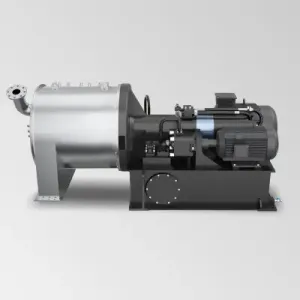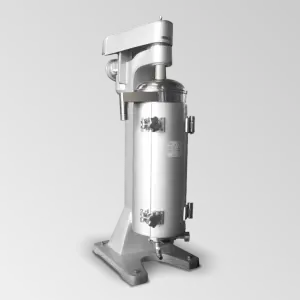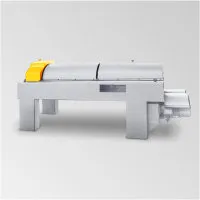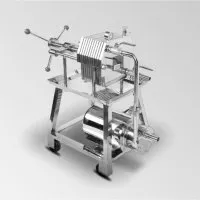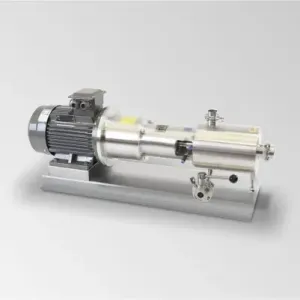Ultrasonic Homogenizer
An ultrasonic homogenizer, also known as an ultrasonic disruptor or sonicator, is a scientific instrument used for sample preparation in various fields, including biology, chemistry, materials science, and food technology. It utilizes high-frequency sound waves to disrupt and homogenize samples, resulting in the dispersion of particles, cell disruption, emulsification, and mixing of components.
SeFluid’s ultrasonic homogenizer series comprises a range of instruments designed to provide efficient and consistent sample processing. The series encompasses different models, each tailored to meet specific requirements of various applications. From small-scale laboratory experiments to large-scale industrial processes, SeFluid offers a comprehensive solution to meet diverse needs.

POWER: 500-3500 w
RESONANT FREQUENCY: 20±1 KMz
MAX. WORK PRESSURE: 5 Mpa
MATERIAL: Titanium alloy
How Ultrasonic Homogenizer Works
The ultrasonic homogenizer works based on the principle of acoustic cavitation. It utilizes high-frequency sound waves to create alternating compression and rarefaction cycles in a liquid medium containing the sample. Here’s a step-by-step explanation of how an ultrasonic homogenizer operates:
- Transducer: The ultrasonic homogenizer consists of a transducer, which is typically made of piezoelectric materials such as ceramics or crystals. The transducer is responsible for converting electrical energy into high-frequency mechanical vibrations.
Generator: The ultrasonic homogenizer is connected to a generator that supplies electrical energy to the transducer. The generator produces high-frequency electrical signals, typically in the range of 20 kHz to a few megahertz, depending on the specific application.
- Probe or Horn: The transducer is attached to a probe or horn, which is immersed in the liquid medium containing the sample. The probe serves as a medium to transmit the mechanical vibrations generated by the transducer to the sample.
- Acoustic Cavitation: When the generator is turned on, the transducer starts vibrating at the desired frequency, generating ultrasonic waves. These waves propagate through the liquid medium and create alternating cycles of compression and rarefaction.
- Bubble Formation: During the rarefaction phase of the sound wave, microscopic bubbles form in the liquid. These bubbles are typically formed at locations with imperfections or dissolved gas in the liquid.
- Bubble Growth: As the rarefaction cycle continues, the bubbles grow in size due to the decrease in pressure. The growth of these bubbles is assisted by the continuous supply of gas from the liquid or the diffusion of gas trapped within the liquid.
- Bubble Collapse: When the compression phase of the sound wave arrives, the pressure increases rapidly, causing the bubbles to collapse violently. This collapse is known as acoustic cavitation.
- Energy Release: The rapid collapse of the bubbles releases a tremendous amount of energy in the form of shockwaves, microjets, and localized heating. The collapse of the bubbles near solid surfaces can generate even higher energy levels.
- Disruption and Homogenization: The energy released during acoustic cavitation creates mechanical forces that disrupt cells, break down particles, and promote mixing within the sample. The intense shear forces, microstreaming, and local temperature increases contribute to the homogenization process.
- Control and Optimization: The ultrasonic homogenizer allows the user to control various parameters such as power, amplitude, and sonication time. These parameters can be adjusted based on the specific sample characteristics and desired outcomes, enabling optimization of the homogenization process.
By utilizing the phenomenon of acoustic cavitation, the ultrasonic homogenizer efficiently disrupts and homogenizes samples, leading to cell disruption, particle dispersion, emulsification, and mixing. The precise control over sonication parameters allows researchers to tailor the process according to their specific needs, resulting in effective sample preparation in various scientific and industrial applications.
Material of Ultrasonic Homogenizer
The material of the ultrasonic horn or probe can vary depending on the specific application and the manufacturer. Common materials used for ultrasonic homogenizer probes include:
Titanium: Titanium is a popular choice due to its high strength, corrosion resistance, and ability to transmit ultrasonic energy efficiently. Titanium probes are suitable for a wide range of applications and are often used in biological and chemical laboratories.
Stainless Steel: Stainless steel is another common material for ultrasonic homogenizer probes. It is durable, resistant to corrosion, and has good mechanical properties. Stainless steel probes are often used for general laboratory applications.
Aluminum: Aluminum is lightweight and has good thermal conductivity. Aluminum probes are suitable for applications where weight is a concern, and they are commonly used in smaller-scale laboratory setups.
Zirconium: Zirconium is chosen for its corrosion resistance and high-temperature stability. Zirconium probes may be used in applications where aggressive chemicals are present.
Plastics: In some cases, plastic materials such as PEEK (polyether ether ketone) or Teflon may be used for probes, especially in applications where chemical compatibility and non-reactivity are critical.
It’s essential to choose the appropriate material based on the specific requirements of your application, taking into consideration factors such as the type of samples being processed, the chemicals involved, and the desired performance characteristics. Additionally, the design and construction of the entire ultrasonic homogenizer system, including the generator and other components, can also vary among manufacturers. Always refer to the manufacturer’s guidelines and recommendations for the specific equipment you are using.
Processing Capacity of Ultrasonic Homogenizer
The processing capacity of an ultrasonic homogenizer, often expressed as throughput or processing speed, can vary widely depending on factors such as the instrument’s design, power output, and the type of samples being processed. The processing capacity is typically measured in terms of the volume of the sample that can be effectively treated within a given time frame.
Some factors that influence the processing capacity of an ultrasonic homogenizer include:
Power Output: The ultrasonic homogenizer’s power, measured in watts or kilowatts, plays a crucial role in determining its processing capacity. Higher power levels generally allow for faster and more efficient sample processing.
Frequency: Ultrasonic homogenizers operate at specific frequencies, typically in the ultrasonic range (20 kHz to several MHz). The frequency can impact the efficiency of sample disruption and the types of samples that can be effectively processed.
Probe Design: The design and geometry of the ultrasonic horn or probe can influence the homogenization efficiency. Different probe designs may be suitable for specific types of samples or volumes.
Sample Characteristics: The nature of the samples being processed, such as their viscosity, composition, and susceptibility to ultrasonic energy, can affect processing speed. Some samples may require more time or a different approach for effective homogenization.
Batch or Continuous Processing: The processing capacity may also be influenced by whether the ultrasonic homogenizer operates in batch mode or continuous flow. Continuous processing systems may offer higher throughput for certain applications.
Manufacturer Specifications: Manufacturers provide specifications for their ultrasonic homogenizers, including recommended operating conditions and maximum processing capacities. It’s important to consult the manufacturer’s documentation for accurate information about a particular device.
It’s crucial to note that the processing capacity may vary for different models and brands of ultrasonic homogenizers. Additionally, the optimal conditions for achieving maximum throughput while maintaining sample integrity should be determined based on the specific requirements of your application.
Processing Mode of Ultrasonic Homogenizer: Batch and Continuous
Ultrasonic homogenizers can operate in either batch mode or continuous mode, and the choice between these modes depends on the specific requirements of the application. Both modes have their advantages and are suitable for different types of processing.
Batch Mode:
- Description: In batch mode, the ultrasonic homogenizer processes a fixed volume of sample at a time. The sample is placed in a container (such as a tube, beaker, or vial), and the ultrasonic probe is immersed in the sample to disrupt and homogenize it.
- Advantages:
- Simple and straightforward setup.
- Well-suited for small to medium-scale laboratory applications.
- Allows for control over the entire batch of samples.
Continuous Mode:
- Description: In continuous mode, the ultrasonic homogenizer processes an ongoing flow of sample. The sample is continuously pumped or flowed through a chamber where the ultrasonic probe disrupts and homogenizes it before it exits the system.
- Advantages:
- Higher throughput and processing speed, making it suitable for larger-scale operations.
- Can be integrated into automated or semi-automated processes.
- Well-suited for applications where a continuous supply of homogenized material is required.
The choice between batch and continuous mode depends on several factors:
Sample Volume: Batch mode is often used for smaller sample volumes, while continuous mode is more efficient for processing larger volumes.
Automation and Integration: Continuous mode is more amenable to automation and integration into larger processing systems, making it suitable for industrial applications.
Processing Speed: Continuous mode generally offers higher processing speeds, making it advantageous for applications where rapid and continuous homogenization is required.
Sample Characteristics: The nature of the sample and the desired level of homogenization can influence the choice of mode. Some samples may be better suited for one mode over the other.
It’s important to refer to the manufacturer’s guidelines and specifications for the specific ultrasonic homogenizer model you are using, as they will provide information on the recommended mode of operation, limitations, and best practices for achieving optimal results. Additionally, considering the specific requirements of your application will help determine whether batch or continuous mode is more suitable for your needs.
Advantages of Ultrasonic Homogenizer
Ultrasonic homogenizers offer several significant benefits in sample preparation and processing. Here are some key advantages of using ultrasonic homogenizers:
- Efficient and Rapid Processing: Ultrasonic homogenizers provide rapid and efficient sample processing compared to traditional methods. The intense cavitation and mixing action generated by high-frequency sound waves ensure thorough homogenization, reducing the time required for sample preparation. This efficiency is particularly beneficial when working with large sample volumes or when a high throughput is needed.
- Versatility: Ultrasonic homogenizers are versatile tools that can accommodate a wide range of sample volumes and viscosities. They can be used for small laboratory-scale samples as well as large-scale industrial batches. The ability to control sonication parameters, such as power, amplitude, and processing time, allows researchers to optimize the homogenization process for different sample types and applications.
- Non-destructive Sample Processing: Ultrasonic homogenization is a non-destructive sample preparation technique. Unlike some other methods that may generate excessive heat or shear forces, ultrasonic homogenizers preserve the integrity and functionality of sensitive molecules, such as proteins, enzymes, and nucleic acids. This non-destructive nature is particularly important in applications where maintaining the native properties of the sample is crucial.
- Homogenization of Various Samples: Ultrasonic homogenizers can effectively homogenize a wide range of samples, including cells, tissues, emulsions, suspensions, and solid materials. They are commonly used for cell disruption, DNA and RNA extraction, protein extraction, particle size reduction, and dispersion of nanoparticles. This versatility makes ultrasonic homogenizers suitable for various scientific disciplines, such as life sciences, pharmaceuticals, nanotechnology, and materials science.
- Scalability: Ultrasonic homogenizers can be easily scaled up for industrial production. The same principles and techniques used in laboratory-scale experiments can be applied to larger batches, allowing for seamless transition from research to commercial applications. This scalability makes ultrasonic homogenizers valuable tools for process development and optimization in industries such as pharmaceuticals, food and beverage, and cosmetics.
- User-Friendly Operation: Ultrasonic homogenizers are designed for ease of use and user convenience. They often feature intuitive control panels, user-friendly interfaces, and programmable settings. Some models also include automated safety features and real-time monitoring capabilities. These user-friendly features enable researchers and operators to perform experiments with precision and confidence.
- Reduced Contamination: Ultrasonic homogenizers minimize the risk of contamination since they do not require additional chemicals or consumables for sample processing. The sample is processed directly in the liquid medium, eliminating the need for harsh solvents or abrasive materials that can introduce contaminants. This benefit is particularly important in applications where sample purity and integrity are critical, such as in the pharmaceutical and biotechnology industries.
- Cost-Effectiveness: Ultrasonic homogenizers offer a cost-effective solution for sample preparation. They eliminate the need for multiple processing steps, additional equipment, and consumables, reducing overall costs. Additionally, the long-term durability and reliability of ultrasonic homogenizers contribute to their cost-effectiveness.
Applications of Ultrasonic Homogenizer
Ultrasonic homogenizers find applications in various scientific fields and industries due to their ability to efficiently disrupt and homogenize samples. Here are some common applications of ultrasonic homogenizers:
- Cell Disruption and Lysis: Ultrasonic homogenizers are widely used in cell biology and biotechnology for cell disruption and lysis. The intense cavitation generated by the high-frequency sound waves can break open cell membranes, releasing cellular contents such as proteins, DNA, RNA, and organelles. This application is valuable for extracting intracellular components, studying cellular processes, and preparing samples for downstream analyses.
- DNA and RNA Extraction: Ultrasonic homogenizers are employed in molecular biology and genetics for DNA and RNA extraction from various biological samples. The mechanical forces generated during sonication aid in the disruption of cells and the release of nucleic acids, facilitating their subsequent purification and analysis.
- Particle Size Reduction: Ultrasonic homogenizers are used to reduce the size of particles, including nanoparticles, microspheres, and emulsion droplets. The intense shear forces and cavitation effects disrupt agglomerates and promote uniform dispersion. This application is crucial in nanotechnology, pharmaceuticals, and materials science for achieving desired particle size distributions and enhancing the effectiveness of drug delivery systems.
- Emulsification and Dispersion: Ultrasonic homogenizers facilitate the production of stable emulsions by promoting the breakup of immiscible liquids into fine droplets. They are commonly used in the food and beverage industry for emulsifying oils, creating stable suspensions, and improving product texture and stability.
Sample Homogenization: Ultrasonic homogenizers are employed to homogenize samples by achieving uniform mixing of components. This application is valuable in chemistry, materials science, and quality control to ensure consistent sample composition and properties. - Sample Preparation for Analytical Techniques: Ultrasonic homogenizers are used to prepare samples for various analytical techniques, including spectroscopy, chromatography, and mass spectrometry. They aid in solubilizing samples, enhancing extraction efficiency, and improving sample uniformity, leading to more accurate and reproducible results.
- Disintegration and Extraction: Ultrasonic homogenizers are utilized in the extraction of bioactive compounds from plant materials, such as herbs and botanicals. The mechanical forces generated during sonication help break down cell walls and release desired compounds, such as flavors, fragrances, and therapeutic compounds.
- Formulation Development: Ultrasonic homogenizers play a crucial role in formulation development in industries such as pharmaceuticals, cosmetics, and personal care. They assist in blending and dispersing ingredients, improving product stability, and achieving desired texture and appearance.
- Sample Degassing and Cleaning: Ultrasonic homogenizers can be used for degassing liquids by removing dissolved gases, such as oxygen or carbon dioxide. They are also employed in the cleaning of laboratory glassware and equipment, utilizing the cavitation effects to dislodge contaminants and facilitate cleaning.
These applications highlight the versatility of ultrasonic homogenizers in various scientific disciplines, including biology, chemistry, materials science, pharmaceuticals, food technology, and cosmetics. The efficient sample processing and homogenization capabilities of ultrasonic homogenizers contribute to advancements in research, development, and quality control in these fields.
The Reason to Choose SeFluid's Ultrasonic Homogenizers
Are you in search of cutting-edge technology that will revolutionize your homogenization process? Look no further than SeFluid’s Ultrasonic Homogenizers, the ultimate solution for achieving unmatched results.
At SeFluid, we understand the significance of precision and efficiency when it comes to homogenization. That’s why our Ultrasonic Homogenizers are designed with state-of-the-art features to meet all your requirements.
Here’s why SeFluid’s Ultrasonic Homogenizers stand out from the competition:
- Unparalleled Performance: Our homogenizers utilize advanced ultrasonic technology, providing precise and consistent results. With adjustable power settings, you have full control to achieve the desired sample disruption, emulsification, and dispersion.
- Innovative Design: Experience the future of sample preparation with our state-of-the-art design. SeFluid’s Ultrasonic Homogenizers are engineered with cutting-edge technology and feature advanced probe designs for maximum efficiency. The sleek and user-friendly interface allows for seamless operation, making it a valuable asset for both seasoned professionals and newcomers alike.
- Versatility at its Best: SeFluid’s Ultrasonic Homogenizers are adaptable to a wide range of applications. Whether you’re in the pharmaceutical, food and beverage, cosmetic, or research industry, our homogenizers deliver exceptional performance across various sample types.
- Time and Cost Efficiency: Say goodbye to lengthy and expensive homogenization processes. Our Ultrasonic Homogenizers offer rapid processing times, enabling you to streamline your production and reduce operational costs without compromising on quality.
- User-Friendly Interface: We believe that technology should be accessible to all users. That’s why our homogenizers feature an intuitive interface, making it easy for operators of all levels to operate and optimize the homogenization process.
- Durability and Reliability: SeFluid takes pride in delivering robust and reliable equipment. Our Ultrasonic Homogenizers are built to endure rigorous usage, ensuring long-lasting performance and minimal downtime.
- Exceptional Customer Support: We stand by our products and our customers. Our dedicated support team is ready to assist you with any inquiries, troubleshooting, or guidance you may need along the way.
Don’t settle for ordinary homogenization methods when you can experience the extraordinary with SeFluid’s Ultrasonic Homogenizers. Take your homogenization process to new heights and witness remarkable results.
Contact us today to learn more about SeFluid’s Ultrasonic Homogenizers and how they can transform your homogenization process. Experience the future of homogenization with SeFluid!
Request for Quotation
NEWS
contact
No 28, Fengxia Rd, Hefei, Anhui Province, China 201400
Phone: +86 156 6910 1862
Fax: +86 551 5843 6163
moc.diulfesobfsctd-13420d@selas







